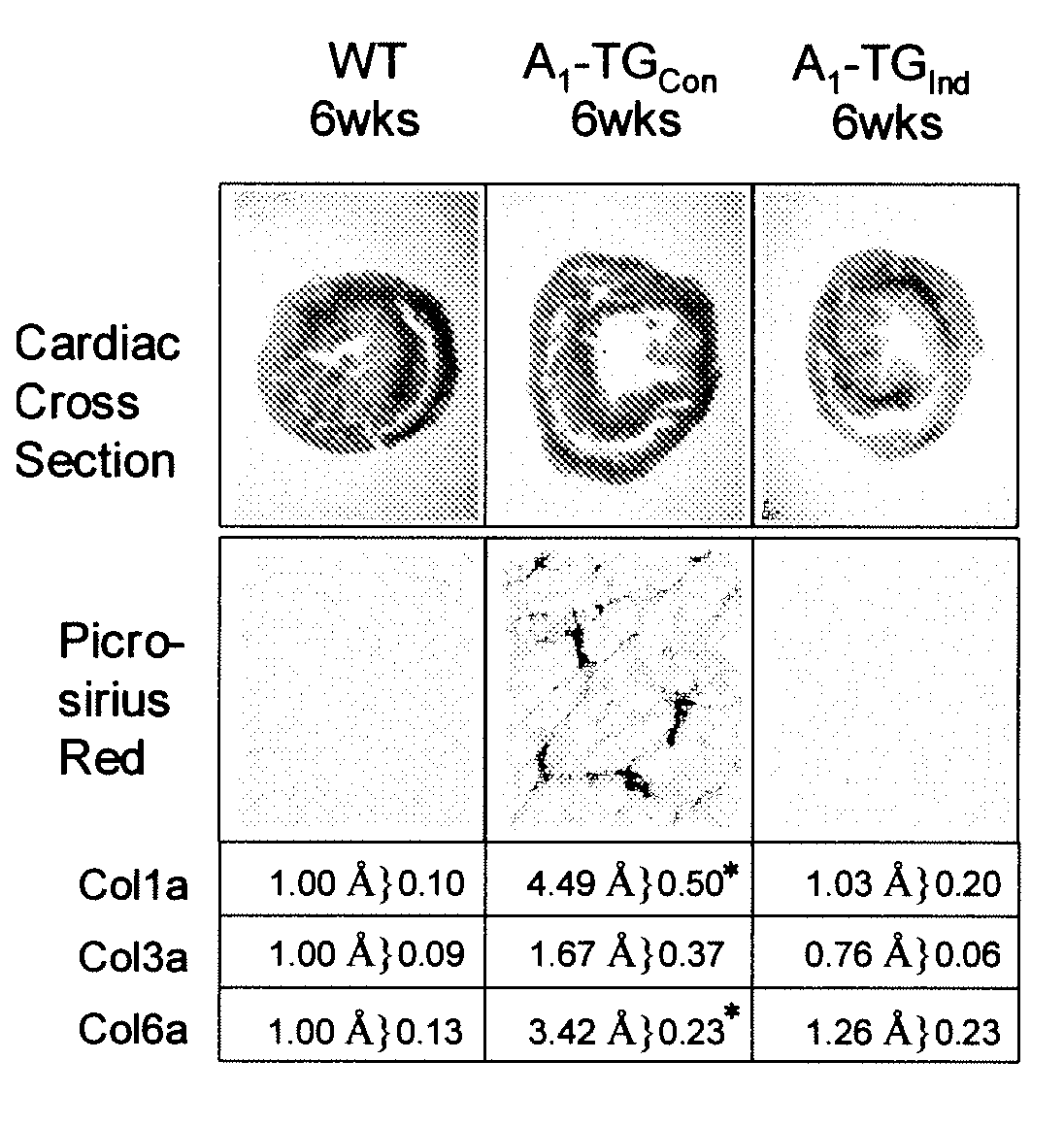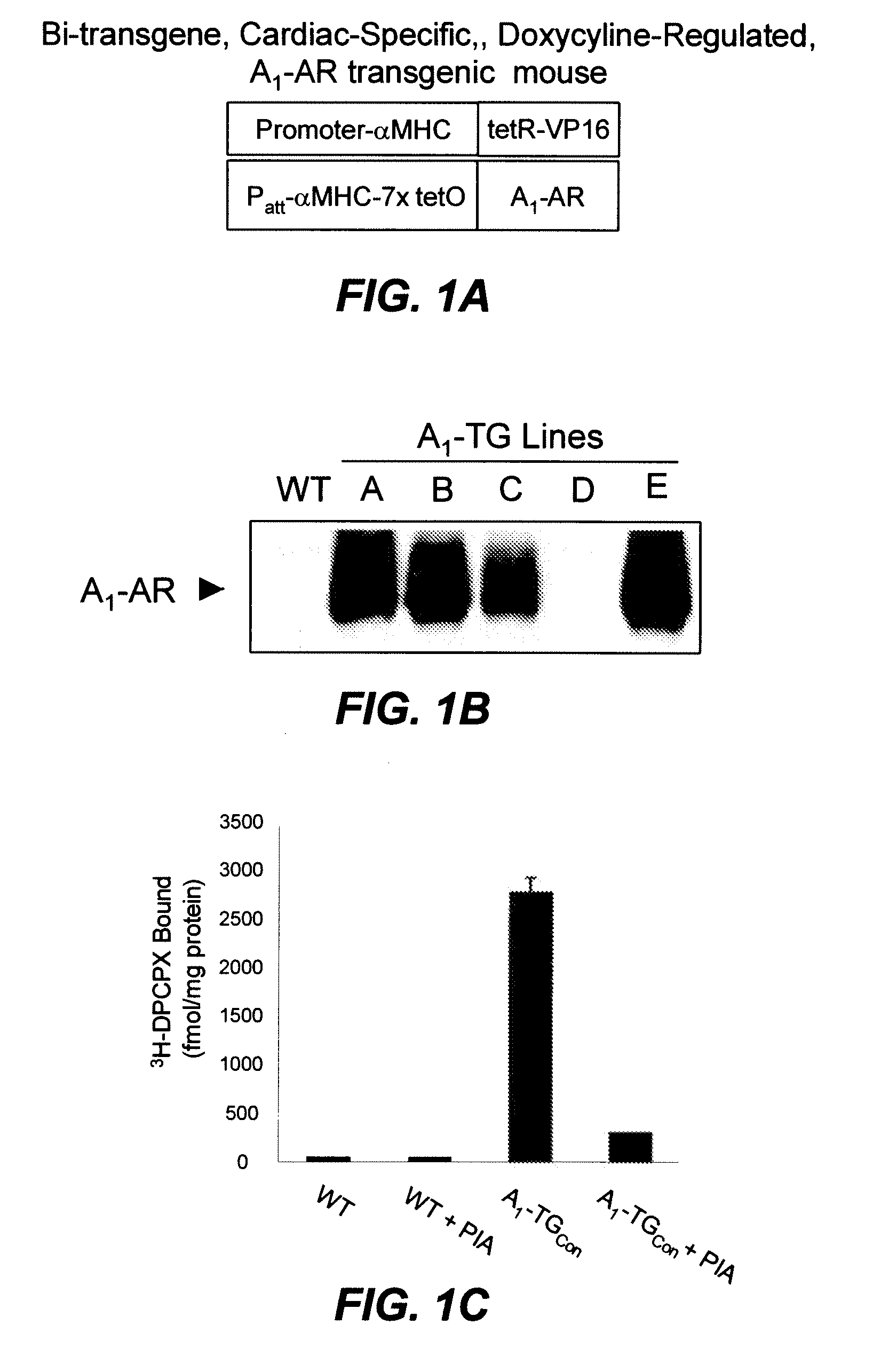Compositions and methods for the treatment and prevention of cardiovascular diseases
a technology for cardiovascular diseases and compositions, applied in drug compositions, antibody medical ingredients, peptide/protein ingredients, etc., can solve the problems of deleterious effects on cardiac function, etc., to restore cardiac function, and cardiac function is not compromised.
- Summary
- Abstract
- Description
- Claims
- Application Information
AI Technical Summary
Benefits of technology
Problems solved by technology
Method used
Image
Examples
example 1
[0217]Inducible and cardiac specific expression of A1-AR. The inventors generated human A1-AR transgenic (A1-TG) mice controlled by an inducible cardiac-specific promoter with binding sites for the tetracyline transactivating factor (tTA). Gene expression was initiated by crossing six founder A1-TG lines with mice that expressed tTA in the heart (MHC-tTA) (FIG. 1A). By immunoblotting, four of the five founder lines showed robust A1-AR protein expression (FIG. 1B). Expression of A1-AR was confirmed by radioligand binding in cardiac membranes using the A1-AR ligand, DPCPX (FIG. 1C). Quantification of immunoblots and radio-ligand binding indicated that these A1-AR transgenic lines expressed the A1-AR at 500-1000 fold above endogenous A1-AR level. Specificity was confirmed by competition with A1-AR antigenic peptide and with excess non-radioactive A1-AR binding ligand (FIG. 1C and data not shown).
[0218]A1-TG lines B and C were chosen for further characterization. Real-time PCR showed th...
example 2
[0219]Doxycyline-regulated A1-AR expression. The stable tetracycline analog, doxycycline (DOX), inhibits tTA transactivation. The inventors determined a minimal dose of DOX (300 mg / kg of mouse diets) that attenuated A1-AR expression, which, in turn prevented cardiomyopathy. As shown in FIG. 2A, when DOX was continuously administered to pregnant mothers and subsequently to the offspring, cardiac A1-AR expression was significantly attenuated at six-week of age comparing to constitutively expressed A1-AR TG mice (A1-TGCon). To generate inducible A1-AR transgenic mice (A1-TGInd), DOX was removed when mice reached three-weeks of age. Time course studies showed that A1-AR was fully re-expressed at six-weeks of age. At six weeks of age, A1-AR protein expression in A1-TGCcon and A1-TGInd was identical (FIGS. 2B and C). DOX inhibition and A1-AR induction are confirmed by A1-AR binding assays (FIG. 2D).
[0220]As reported previously,33 the MHC-tTA mouse line expressed tTA at very low levels. Th...
example 3
[0221]Constitutive and Induced Overexpression of A1-AR. As shown by the induction scheme (FIG. 3A), A1-AR was either expressed constitutively in the absence of DOX (A1-TGCon) or expression was induced (A1-TGInd) by removing DOX at three weeks of age. Constitutive A1-AR overexpression in two A1-TG lines led to development of a dilated cardiomyopathy and high mortality in both male and female mice. Almost all A1-TGCon mice died within 6-12 weeks depending on the founder line (FIG. 3B). It should be noted that the higher mortality rate of line B was associated with a higher A1-AR protein expression (FIG. 1B). Mice died of apparent congestive heart failure (post-mortem cardiac hypertrophy and dilation; pleural effusion). Both male and female mice showed similar mortality rate and phenotype (data not shown). In contrast, when A1-AR expression was delayed until mice reached 3 weeks of age, over 90% of A1-TGInd mice survived 30 weeks or longer despite comparable levels of A1-AR overexpress...
PUM
| Property | Measurement | Unit |
|---|---|---|
| Cell angle | aaaaa | aaaaa |
| Biological properties | aaaaa | aaaaa |
Abstract
Description
Claims
Application Information
 Login to View More
Login to View More - R&D
- Intellectual Property
- Life Sciences
- Materials
- Tech Scout
- Unparalleled Data Quality
- Higher Quality Content
- 60% Fewer Hallucinations
Browse by: Latest US Patents, China's latest patents, Technical Efficacy Thesaurus, Application Domain, Technology Topic, Popular Technical Reports.
© 2025 PatSnap. All rights reserved.Legal|Privacy policy|Modern Slavery Act Transparency Statement|Sitemap|About US| Contact US: help@patsnap.com



